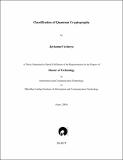Please use this identifier to cite or link to this item:
http://drsr.daiict.ac.in//handle/123456789/50| Title: | Classification of quantum cryptography |
| Authors: | Jadhav, Ashish Acharya, Jaykumari |
| Keywords: | Ciphers Cryptography Quantum cryptography |
| Issue Date: | 2004 |
| Publisher: | Dhirubhai Ambani Institute of Information and Communication Technology |
| Citation: | Acharya, Jaykumari (2004). Classification of quantum cryptography. Dhirubhai Ambani Institute of Information and Communication Technology, x, 104 p. (Acc.No: T00013) |
| Abstract: | Modern Classical Cryptography is divided into two parts. The first part is Asymmetric (public-key) cryptography and the second is Symmetric (private or secret-key) cryptography. In spite of its popularity public-key cryptography has major flaws. Fast factoring algorithms or computers with fast processing power can break the public-key cryptographic system. In the case of private key cryptography, it is expensive to distribute the key via a trusted carrier or personal meetings. So, to overcome these drawbacks of classical cryptography, a cryptographic scheme based on the principles of quantum physics was developed. Quantum Cryptography provides unconditional security. Quantum cryptographic systems are provably secure systems that uses public channel for the distribution of the secret key. To get unconditional security quantum cryptography uses the principles of quantum physics like No-cloning theorem, Heisenberg’s uncertainty principle and quantum entanglement. Here, Classification of Quantum Cryptography is proposed. Quantum Cryptography is an alternative for the Classical Cryptography especially to have unconditional security. Classification may help the designer for an appropriate choice of the quantum cryptographic techniques. |
| URI: | http://drsr.daiict.ac.in/handle/123456789/50 |
| Appears in Collections: | M Tech Dissertations |
Files in This Item:
| File | Description | Size | Format | |
|---|---|---|---|---|
| 200211020.pdf Restricted Access | 399.17 kB | Adobe PDF |  View/Open Request a copy |
Items in DSpace are protected by copyright, with all rights reserved, unless otherwise indicated.
